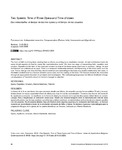Mostrar o rexistro simple do ítem
Two Speeds: Time of Three Opera and Time of Users
| dc.contributor.author | Leto, Francesca | |
| dc.date.accessioned | 2020-04-20T09:40:44Z | |
| dc.date.available | 2020-04-20T09:40:44Z | |
| dc.date.issued | 2020 | |
| dc.identifier.citation | Leto, Francesca. 2019. «Dos Velocidades: El Tiempo De Las Tres óperas Y El Tiempo De Los Usuarios». Actas De Arquitectura Religiosa Contemporánea 6 (diciembre), 68-83. https://doi.org/10.17979/aarc.2019.6.0.6230 | es_ES |
| dc.identifier.issn | 2340-5503 | |
| dc.identifier.uri | http://hdl.handle.net/2183/25373 | |
| dc.description.abstract | [Resumen] La forma de la fe es una forma viva que comienza desde una Urform, de acuerdo con una forma estética. El arte y la arquitectura tienen la misma capacidad virtual de ritual para crear el mundo contraintuitivo. Tenemos dos formas de transmitir fe: repetición y emoción. La repetición es la forma de ritual y la emoción es lo que las tres óperas deben tener en común. Liturgia, Arte y Arquitectura se entienden como opus. Existe una relación temporal entre la transformación vital de estas ópera y el usuario. Las formas cambian con el tiempo y deben continuar comunicándose en función de una relación positiva con los usuarios. En el contexto italiano, hay una fractura entre algunos usuarios y la realización del formulario. La fractura necesita ser reconciliada a través de la educación adecuada de fieles y líderes. Se destaca el proceso metodológico para la adaptación litúrgica de la iglesia de los padres tolentinos, en Venecia, realizada por Alberto Gianfreda. | es_ES |
| dc.description.abstract | [Abstract] The form of faith is a living form, starting from a Urform, according to an aesthetics manner. Art and architecture have the same virtual capacity of ritual to create the counterintuitive world. We have two ways of transmitting faith: repetition and emotion. Repetition is the form of the ritual and emotion is what all the three opera must have in common. Liturgy, Art and Architecture are understood as opus. There is a temporal relationship between vital becoming of this three opera and the user. Forms change over time and they should continue communicating on the basis of a positive relationship with users. In the Italian context there is a fracture between some users and the making of the form. The fracture needs to be reconciled through an appropriate education of principals and worshippers. The methodological process for Alberto Gianfreda’s liturgical adaptation of Tolentini’s church in Venice is brought to attention. | es_ES |
| dc.language.iso | eng | es_ES |
| dc.publisher | Universidade da Coruña | es_ES |
| dc.relation.uri | https://doi.org/10.17979/aarc.2019.6.0.6230 | es_ES |
| dc.rights | Atribución-NoComercial 4.0 España | es_ES |
| dc.rights.uri | http://creativecommons.org/licenses/by-nc/3.0/es/ | * |
| dc.subject | Opera | es_ES |
| dc.subject | Repetition | es_ES |
| dc.subject | Emotion | es_ES |
| dc.subject | Alberto Gianfreda | es_ES |
| dc.subject | Tolentini | es_ES |
| dc.subject | Repetición | es_ES |
| dc.subject | Emoción | es_ES |
| dc.subject | Tolentinos | es_ES |
| dc.title | Two Speeds: Time of Three Opera and Time of Users | es_ES |
| dc.title.alternative | Dos velocidades: el tiempo de las tres óperas y el tiempo de los usuarios | es_ES |
| dc.type | info:eu-repo/semantics/article | es_ES |
| dc.rights.access | info:eu-repo/semantics/openAccess | es_ES |
| UDC.journalTitle | Actas de Arquitectura Religiosa Contemporánea | es_ES |
| UDC.volume | 6 | es_ES |
| UDC.startPage | 68 | es_ES |
| UDC.endPage | 83 | es_ES |






